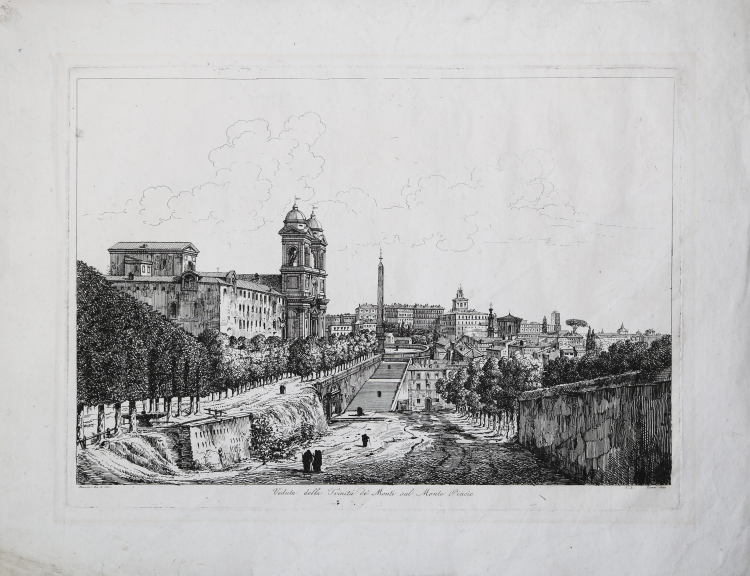


| Reference: | S45831 |
| Author | Luigi ROSSINI |
| Year: | 1820 |
| Zone: | Trinità dei Monti |
| Printed: | Rome |
| Measures: | 392 x 283 mm |


| Reference: | S45831 |
| Author | Luigi ROSSINI |
| Year: | 1820 |
| Zone: | Trinità dei Monti |
| Printed: | Rome |
| Measures: | 392 x 283 mm |
Luigi ROSSINI (Ravenna 1790 - Roma 1875)
|
After training at the Academy of Fine Arts in Bologna, where he studied the engraver Francesco Rosaspina and the painter of decorations Antonio Basoli, in 1813 he won the prize of theRegno Italico for architecture, consisting of a board of three years in Rome at Palazzo Venezia, decisive for his artistic career. Here he realized that his attempts to act as architect failed, discovering instead the engravings of Giovanni Battista Piranesi and, through the work of the great Venetian engraver, he is part of the artistic tradition of engraved view. In 1817 Rossini publishes Frontespizio delle antichità di Roma divise in 40 vedute disegnate dal vero dall'architetto Luigi Rossini, that later reprint with the addition of new plates. In those years he also began working with Bartolomeo Pinelli, which will populate the views by Rossini with his distinctive characters. The fruitful relationship between the two artists will continue until the death of Pinelli took place in 1835. Between 1819 and 1823 he engraved, in 101 tables,Le Antichità Romane ossia raccolta delle più interessanti vedute di Roma antica, disegnate ed incise dall'architetto Luigi Rossini. Between 1824 and 1826 Rossini engraved the etchings Le Antichità dei contorni di Roma, and, two years later, publishes I monumenti più interessanti di Roma dal decimo secolo fìno al secolo decimottavo. In 1829 he returns to his favorite themes of antiquity etchings luce Le porte e le mura del recinto di Roma in 35 tavole. In 1837, Rossini was appointed member of theAcademy of Fine Arts of San Luca, which then become academic merit in 1843.
In 1839 he published Viaggio pittoresco da Roma a Napoli in 80 vedute, a sort of modern tourist guide. He died in Rome on 22 April 1875, after an illness that had forced him to bed paralyzed for five years.
|
Luigi ROSSINI (Ravenna 1790 - Roma 1875)
|
After training at the Academy of Fine Arts in Bologna, where he studied the engraver Francesco Rosaspina and the painter of decorations Antonio Basoli, in 1813 he won the prize of theRegno Italico for architecture, consisting of a board of three years in Rome at Palazzo Venezia, decisive for his artistic career. Here he realized that his attempts to act as architect failed, discovering instead the engravings of Giovanni Battista Piranesi and, through the work of the great Venetian engraver, he is part of the artistic tradition of engraved view. In 1817 Rossini publishes Frontespizio delle antichità di Roma divise in 40 vedute disegnate dal vero dall'architetto Luigi Rossini, that later reprint with the addition of new plates. In those years he also began working with Bartolomeo Pinelli, which will populate the views by Rossini with his distinctive characters. The fruitful relationship between the two artists will continue until the death of Pinelli took place in 1835. Between 1819 and 1823 he engraved, in 101 tables,Le Antichità Romane ossia raccolta delle più interessanti vedute di Roma antica, disegnate ed incise dall'architetto Luigi Rossini. Between 1824 and 1826 Rossini engraved the etchings Le Antichità dei contorni di Roma, and, two years later, publishes I monumenti più interessanti di Roma dal decimo secolo fìno al secolo decimottavo. In 1829 he returns to his favorite themes of antiquity etchings luce Le porte e le mura del recinto di Roma in 35 tavole. In 1837, Rossini was appointed member of theAcademy of Fine Arts of San Luca, which then become academic merit in 1843.
In 1839 he published Viaggio pittoresco da Roma a Napoli in 80 vedute, a sort of modern tourist guide. He died in Rome on 22 April 1875, after an illness that had forced him to bed paralyzed for five years.
|